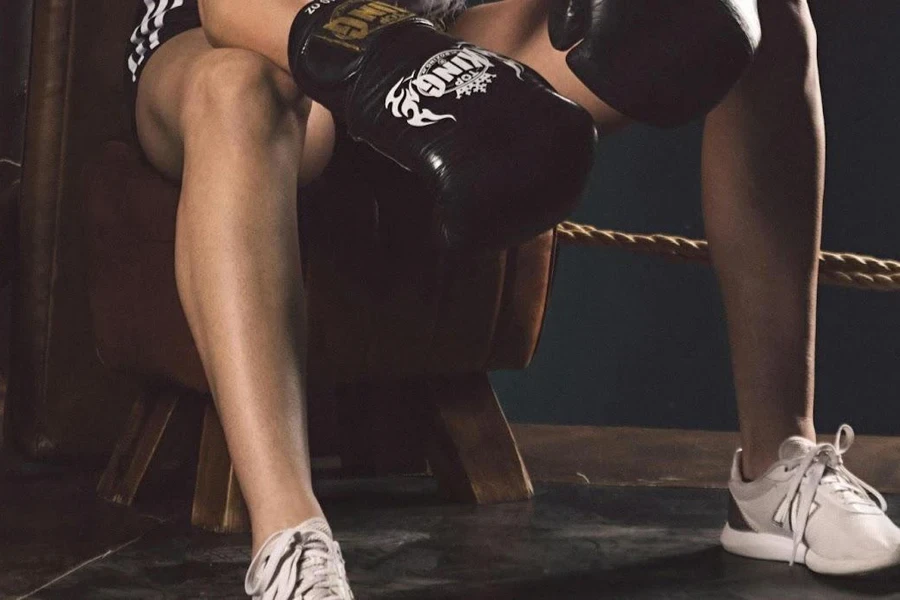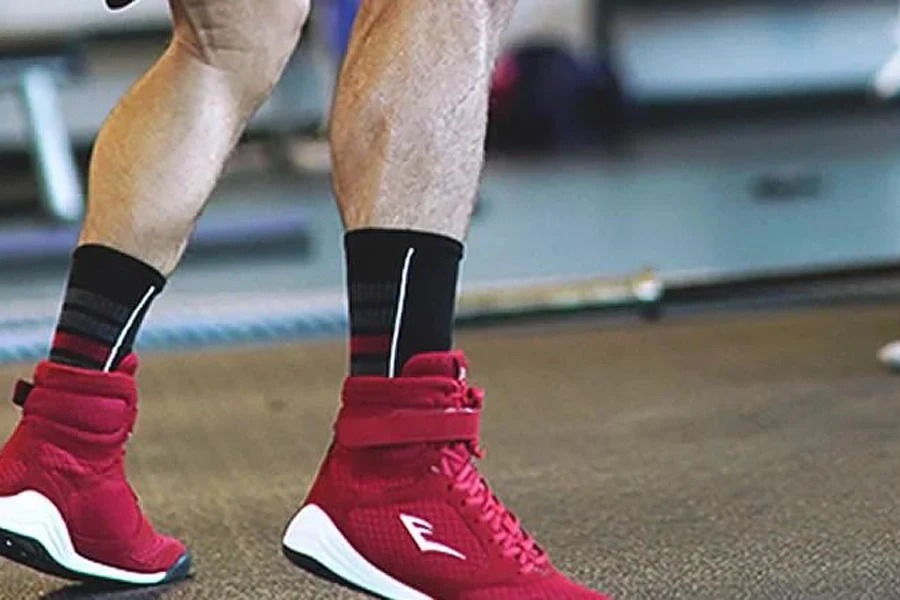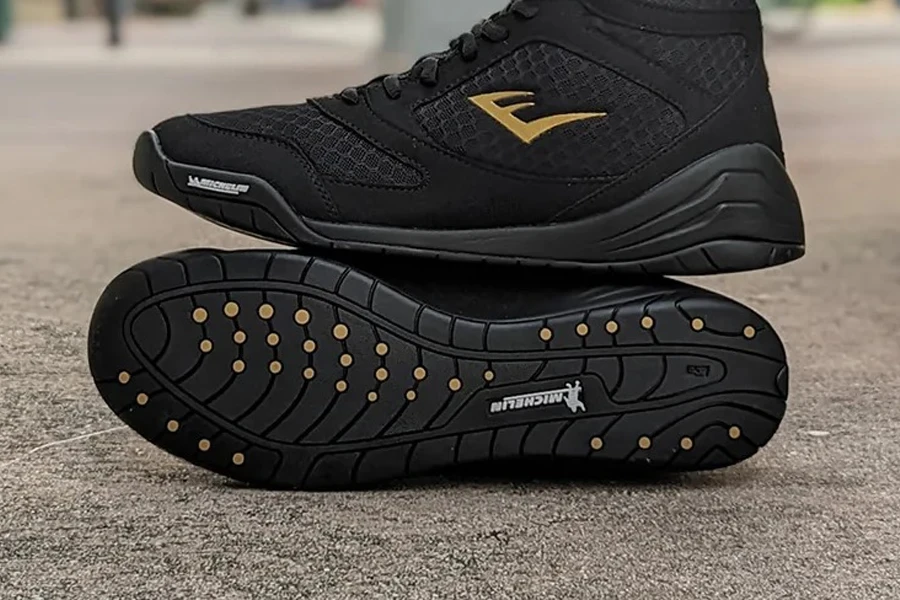Boxing may be about throwing powerful blows, but footwork is another important aspect boxers can’t overlook. Whether it’s generating enough power for the knockout punch or pulling off nimble movements, boxers won’t be able to perform at their best without the right shoes. This is because a great pair of boxing shoes means excellent movement in the ring.
However, offering consumers the ideal boxing shoes can be challenging. Luckily, this comprehensive buying guide provides everything business buyers need to know before stocking up on boxing shoes in 2024.
Table of Contents
How fast is the boxing equipment market growing?
Why sell boxing shoes in 2024?
6 buying tips for boxing shoes as a retailer
Final words
How fast is the boxing equipment market growing?
The boxing equipment market is experiencing growth from US$ 1.5 billion in 2022 to a predicted US$ 3.1 billion by 2032. Experts predict the market will also register a 7.4% compound annual growth rate (CAGR) over the forecast period (2023 to 2032). Based on the report, the boxing equipment market is still rising due to the growing interest in boxing as a form of fitness training.
The report revealed that expanding professional boxing events, televised matches, and championships drive sales to the boxing equipment market. Interestingly, the amateur boxers segment funneled more sales for the global market, holding around 65% of the total share. North America also led the boxing equipment market, holding a 57% share.
Why sell boxing shoes in 2024?

It’s tempting to assume that regular running shoes are enough for boxing, but they are not designed to handle the demands of the sport. Whether seasoned professionals or beginners, boxers need specialized boots to optimize their performance in the ring. Also, proper footwear is essential for maximizing movement flexibility, ensuring foot comfort, and, ultimately, unleashing the wearer’s full potential.
Boxing shoes will remain popular in 2024 due to their benefits, such as superior ground grip, enhanced freedom of movement, smoother gliding capabilities, improved speed and stability, better breathability, maximized ankle support and comfort, and increased power generation. They are also more sturdy than regular running shoes.
Moreover, the Summer Olympics will be held in Paris, France, from Friday, July 26th, 2024, to Sunday, August 11th, 2024. Hence, it’s expected that the demand for boxing shoes will surge. The quadrennial sporting event presents an amazing opportunity for business buyers to boost their sales. With careful planning and early purchase of these shoes, businesses can capitalize on the event’s hype and generate significant revenue before and during the tournament.
6 buying tips for boxing shoes as a retailer
Type

Boxing shoes come in three unique variants, each with attractive features and advantages. Here’s a closer look at each boxing shoe type.
Low-top
These boxing shoes are the lightest—with designs that rest on the ankles and have the least fabric and material. With low-tops, consumers can move around with maximum speed but at the cost of some ankle support.
Mid-top
Consumers often go for mid-tops when they want that sweet middle spot for boxing shoes. They are higher than low-tops but shorter than high-tops—a perfect balance of support and movement speed. Plus, mid-tops are great for boxers who prefer sideway movements and frequent angle changes.
High-top
High-tops offer maximum support at the cost of some movement speed. These shoes help boxers plant a firm foot to deliver massive punches, so they appeal more to power-focused boxers than maneuvers.
➕ Find more boxing shoes for bulk orders

Size

Like every piece of footwear, boxing shoes must be comfortable for consumers to reach their full potential. One thing to avoid when choosing boxing shoe sizes is longer models—they affect the wearer’s control. Instead, the perfect boxing shoe size should have snugger fits for better in-game movements. Check the table below for a complete boxing shoe size chart.
| US Men’s | US Women’s | UK Sizes |
| 5 | 6.5 to 7 | 38 |
| 6 | 7.5 to 8 | 39 |
| 7 | 8.5 to 9 | 40 |
| 8 | 9.5 to 10 | 41 |
| 9 | 10.5 to 11 | 42 |
| 10 | 11.5 to 12 | 43 |
| 11 | 12.5 to 13 | 44 |
| 12 | 13.5 to 14 | 45 |
| 13 | 14.5 to 15 | 46 |
Material

Usually, manufacturers make boxing shoes from leather. However, nowadays, they use other synthetic materials to create even better boxing shoes. Regardless, each one still offers something amazing in today’s market.
For instance, leather shoes often have slightly heavier designs that may restrict the wearer’s movements. But this heavier design makes them more durable and offers better protection. In contrast, synthetic materials are less durable but offer lightweight designs, making them better for mobility-focused boxers.
Additionally, due to technological advancements, boxing shoes come in synthetic leather variants. These shoes provide the best of both worlds, blending durability and lightweight designs. They also offer better cushioning and breathability, making them great all-rounders.
Ankle support

Proper ankle support is critical in boxing, where weight distribution and foot positioning change constantly. Hence, business buyers must not overlook this aspect when choosing boxing shoes. So, how can they know what ankle support is great for their target consumers?
It’s easy. Offering high-top shoes for consumers prone to leg injuries will be more appealing. However, if target consumers prefer more mobility, businesses will make more sales by providing low-top or mid-top options.
Thickness and weight
Like regular shoes, consumers often choose their shoe size and weight based on physical dimensions. So, it makes sense that boxers also select their preferred thickness depending on their leg’s size and shape. More importantly, boxing shoe thickness depends on the materials manufacturers use to make them, while weight affects mobility in the ring. Thinner shoes often have lighter weights, so boxers can move faster and make explosive movements. Conversely, heavier shoes involve thick soles and dense upper fabrics, giving them impressive stability and control.
Sole type

The sole type of boxing shoes also determines the wearer’s performance in the game. In addition to influencing movement, balance, weight distribution, and pivoting, boxing shoe soles also influence how comfortable a boxer will be in the ring. But that’s only the surface—professional boxing requires more details on the sole type.
Professional boxers often prefer shoes featuring grooved rubber soles. They offer superb traction without adding any unwanted weight. That way, consumers can throw explosive blows while achieving greater speed to dodge and maneuver the opponent easily.
Sole thickness is another crucial consideration here. Thicker soles are more durable but may create a sense of detachment from the ground, making them less common for boxing shoes. On the other hand, lighter soles, while less enduring, allow enhanced power generation through improved ground contact.
Final words
The world of boxing shoes may be vast, but finding the right pair shouldn’t be a hassle. Thankfully, this guide will help point business buyers in the right direction. While the functional aspect of boxing shoes deserves all the attention, retailers must not leave out their aesthetic appeal.
From classic designs to bold colorways, the choices to attract consumers are endless. Boxing shoes are also in high demand this year, so business buyers should not hesitate to add them to their sports inventory. They attracted a healthy 110,000 searches in March 2024. To continue getting more articles like this, don’t forget to subscribe to the Sports section of Alibaba Reads.
➕ Explore more low MOQ sports shoes for bulk orders





